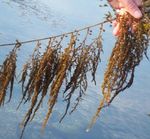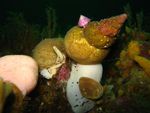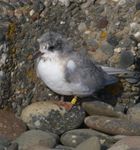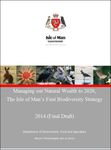Biodiversity Matters - Isle of Man Government
←
→
Page content transcription
If your browser does not render page correctly, please read the page content below
Biodiversity Matters
Issue 7 DEFA’s Biodiversity News July 2014
Biosphere Vannin Recent News
In a nutshell, Biosphere Vannin is all about active A new bee record for the IoM
conservation of everything we’re proud of in our beautiful BugLife, a charity devoted to the conservation of
and unique Island. To quote from UNESCO “Biosphere invertebrates, has been contracted by DEFA to survey the
reserves are areas of terrestrial and coastal ecosystems invertebrates of Manx soft cliffs, a naturally eroding habitat
promoting solutions to reconcile the conservation of with specialist species that are adapted to warm, open
biodiversity with its sustainable use”. sites.
Biosphere reserves serve in some ways as 'living The study is not yet complete but a Halictid bee,
laboratories' for testing out and demonstrating integrated Lasioglossum minutissimum, has been found by Sarah
management of land, water and biodiversity. DEFA and Henshall at Glen Wyllin and Orrisdale Head. This species
partners are working hard to complete the nomination has not been recorded previously on the Isle of Man. It is a
paper to put the Island and its sea forward as a UNESCO small and rather uncommon species of sandy heaths and
Biosphere Reserve, Biosphere Vannin. cliffs. It will be worth looking out for its related parasite
(http://biospherevannin.im/). Sphecodes longulus, which is in the same bee family.
There are clearly still many unrecorded terrestrial inverte-
During the year there has been a stakeholder workshop to brates on the Isle of Man and further study is warranted.
discuss the three zones (core, care, and living and Dr Richard Selman
working), a photographic competition, a Facebook page
Events
has been set up (https://www.facebook.com/#!/
To find out about the wide
biospherevannin) and various maps are being prepared.
range of forthcoming events
The Biosphere Reserve is seen as a way to meet some of
organised by wildlife and
the objectives of the Biodiversity Strategy. Fingers crossed
countryside groups see:
for the success of the bid!
Liz Charter http://www.manxbiodiversity.org/
Department of Environment, Food and Agriculture
Rheynn Chymmyltaght, Bee as Eirinys
Our Island, Our Environment, Our Future
Thie Slieau Whallian, Foxdale Road, St Johns, Isle of Man IM4 3AS
Telephone: (01624) 685835 Email: defa@gov.im Website: www.gov.im/defaBiodiversity Matters Issue 7 July 2014
Widows cause arachnophobia Biodiversity Strategy
This last year there has been a surge in public interest in spiders,
led by news items in the UK regarding false widow spiders and
spider bites. There are very few spider species here that can
In August
produce a noticeable bite on a human, and this is only likely in
and
handling them, or inadvertently threatening them, such as sitting
September
on one! However, the larger species of false widow spider,
2013 the
though shy by nature, are capable of biting, with an effect consid-
Strategy
ered equivalent to a bee sting. There are two species of interest in
was
this regard. Steatoda grossa was first recorded on the Isle of Man
released for
when I found it at Kirk Michael in 2010, and it has since been
public
reported from Douglas in 2014. This species is native to Britain.
consultation
The somewhat larger, well-marked, Steatoda nobilis, I identified
and many
from a Port St Mary specimen found in 2013. It is thought to have
positive
been introduced to Britain in the late nineteenth century.
responses
Specimens of both species have been lodged with the Manx
were
Museum, where anyone interested can view them.
received.
The only Manx spider bite that I am aware of, was one reported
from Douglas this year, but no specimen was available for
identification. Most queries that have resulted from the media
interest have turned out to be common, harmless species, such as
Amaurobius, and one interesting query was identified as the cave In June DEFA approved the Biodiversity Strategy,
spider Meta menardi, but living in a compost bin, rather than its Managing our Natural Wealth to 2020. The
usual cave and mine sites. Anyone interested can access good intention is to work with DEFA’s new Minister,
information on false widow spiders and other species on the Richard Ronan to ensure he is comfortable with
websites of the Spider Recording Scheme, the Natural History the document and minor updates are made before
Museum and Garden Safari, and we recommend checking the it is taken to Tynwald for adoption in the autumn.
pictures of similar reported species before requesting further Liz Charter
advice. Dr Richard Selman
The Ayres National Nature Reserve
It has been a turbulent 12 months on the Ayres NNR. The winter tidal storm surges caused massive erosion to the fore
dunes and a large amount of litter and marram grass were deposited along a newly created strand line in the dunes.
Approximately 50 shag corpses were found on the beach and it is likely that these were unable to feed during the
storms and died from starvation. The remote weather monitoring station at the Point of Ayre run by Ronaldsway Met
Office recorded more than double the average rain fall for January and the largest floods on the NNR in living memory
ensued. The inundation lasted for four months seriously hindering access for visitors and local dog walkers.
Page 2Biodiversity Matters Issue 7 July 2014
Several species not usually recorded on the NNR took advantage of
the newly created lakes including tufted duck and many wetland
birds bred in good numbers including mallard, teal, coot and
moorhen. In addition a four-spotted chaser was recorded on the
NNR for the first time. Negative impacts of the floods included the
loss of some lichen heath, a globally rare habitat and the nationally
rare field gentian that flowers in September is also likely to have
suffered.
Exceptional numbers of little terns have been recorded on the NNR
this year with 60 pairs attempting to breed. Unfortunately there has
been massive egg predation with many clutches being raided by
hedgehogs. This may be an after effect of the tidal storm surges
and floods; the floods will have pushed the hedgehogs into the
dunes and the heaps of marram grass left by the tidal storm surges
have provided perfect day time/nesting cover. So far 17 little terns
have fledged and there are still chicks and eggs on the beach and so Arctic tern chick on the verge of fledging
hopefully more will follow. Rene Beijersbergen, a Dutch researcher, and showing the coloured ring
visited the Island in June to collect data on the feeding behaviour of © Sean Gray www.grayimages.co.uk
the Manx little tern colony.
This is the first time any research of this type has been undertaken on the Isle of Man and Rene will be publishing his
results in due course. There have also been exceptionally good numbers of Arctic terns recorded at the Point on land
owned by Bride Sand and Gravel with at least 30 pairs recorded. Unfortunately these have also suffered very high egg
predation and brown rats have been monitored raiding the eggs here. So far 7 chicks have hatched successfully and
several birds are still incubating and so we should at least see some fledged young this year. This year there has been
at least three first summer Arctic terns (black legs and beak) present at the Point, it is quite unusual for these birds to
travel back to their breeding grounds in their first year.
The Manx Ringing Group have fitted both little terns and Arctic terns with coloured lettered rings and it is hoped that
the ringing project will provide information on their migration routes, their wintering grounds and movements between
nesting colonies. Ringing data so far has shown that little terns ringed as chicks at Foulney Island Burrow-in-Furness,
The Breaches Kilcoole Wicklow and Brora Highland have all nested on the NNR and one of these birds was 13 years old.
In addition two Arctic terns ringed as chicks at the Point in 1999 were seen nesting at the Point this year.
This year volunteer nest recorders undertook training and have been issued with licenses to monitor ringed plover and
oystercatcher nests. Sixty-four ringed plover clutches and forty-six oystercatcher clutches were monitored with
most having successful outcomes at the hatching stage. Large chicks and juveniles of both species are being regularly
recorded on the beach. Curlews also appear to have done well on the NNR this year with one pair being recently
sighted at Ballaghennie with 3 chicks not far off fledging.
For information on the NNR or if you would like to get involved with wildlife monitoring or volunteering on the NNR/
DEFA estate please contact Louise Samson on 365131.
Marine invasive species
In April, Dr Liz Cook from the Scottish Association of Marine Science
in Oban came and trained government and non-government people
in marine invasive species identification and strategies to deal with
them.
The Island already has a few marine invasives. Sargassum
seaweed also known as wireweed, has colonised many of our
shallow rockpools in the last 8 years.
There are other invasive species with the potential to cause various
types of damage, such as the carpet sea squirt (Didemnum
vexillum) which has been an expensive problem in Holyhead. DEFA
will be writing a strategy for addressing invasives both on land and
in the sea, as outlined in the Biodiversity Strategy.
Liz Charter
Page 3Biodiversity Matters Issue 7 July 2014
Areas of Special Scientific Interest
The Government working with landowners to
conserve our natural heritage
The Isle of Man contains many areas of
particular interest for their wildlife habitats,
geological features and landforms. Some
are important as wildlife havens, as
laboratories for science, or as educational
resources displaying our geological history
and richness of wildlife. Areas of Special
Scientific Interest are given legal protection
as the best examples of this natural
heritage. There are currently 21 ASSIs
covering a total area of 2,299 hectares
(5,681 acres).
Cronk e King ASSI: a series of upland-fringe hay meadows where three For further information see:
species of orchids have been recorded and dark green fritillary http://www.gov.im/categories/the-
butterflies are regularly seen feeding on red clover. environment-and-greener-living/protected-
sites/ Aline Thomas
The Isle of Man’s most bio-diverse marine habitat
In the last edition of ‘Biodiversity Matters’ we reported on a meeting of horse mussel (Modiolus modiolus) researchers
in Port Erin. Several members of the group subsequently made dives on horse mussel reefs off the Point of Ayre and
south of Douglas, collecting ‘clump’ samples of 25x25cm 2 and continuing with a long-term monitoring programme. The
samples from the Douglas site were then sent to two taxonomic experts, one for epifauna (typically the larger, surface
organisms) and one for infauna (the smaller, sediment-living animals) to provide a definitive species identification and
biodiversity indication.
The results were a very positive surprise, with a total of 296 individual species being identified from the sample. This
makes it the second most bio-diverse horse mussel sample ever recorded in the British Isles, after a mussel reef in
Shetland which recorded 297 species. From a local perspective it is also the most bio-diverse site we know of within the
Manx Territorial Sea, and possibly within the whole Island, including terrestrial habitats. These results indicate the
relevance and importance of these mussel reefs to the local and regional marine biodiversity, and emphasise the
importance of protecting them, not only for the varied habitat they provide, but also as important nursery grounds and
food supply for commercial fisheries species (http://jncc.defra.gov.uk/pdf/UKBAP_BAPHabitats-18-
HorseMusselBeds.pdf).
Horse mussel reefs are listed as Threatened and/or Declining Species and Habitats under the OSPAR Convention, to
which the Isle of Man is a signatory, and therefore we have commitment to preserving such areas (http://
www.ospar.org/). Dr Peter Duncan
For further information please contact Dr Fiona Gell (Fiona.Gell@gov.im). Photographs by Caroline Perry & Phil Roriston
Page 4You can also read

























































